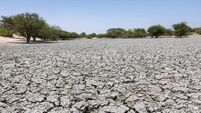Climate change putting Ireland's economic stability at risk, Central Bank warns

The flooding in Midleton after Storm Babet in October 2023. The joint report said many adaptation projects, particularly at local levels, are seen as too small or too uncertain to secure funding. File photo: Guileen Coast Guard unit.
Climate change is putting Ireland’s financial system and its long-term economic stability at risk, and investment to cope with extreme weather events is urgent and essential, the Central Bank has said.
In a joint report with the Climate Change Advisory Council, it warned that the current level of finance for climate adaptation here is not enough to cope with the escalating risks of climate change.
Without action, the impact of extreme weather events will put the country’s economic and financial resilience to the test with as much as €2.2bn a year needed by 2030 in annual adaptation expenditure.
“We’re already seeing the impact extreme weather has on communities, businesses and infrastructure, and we recognise the importance of addressing climate-related risks, including the growing need for investment in adaptation measures,” deputy governor of monetary and financial stability at the Central Bank, Vasileios Madouros, said.
“Safeguarding Ireland’s financial stability in the face of a changing climate requires collaboration across public and private sectors, enabling investment at both national and local levels, and further assessing the short- and long-term costs of climate adaptation.”

The joint report said while work is ongoing to reduce Ireland's emissions, alongside that a focus should be put on addressing the impact of climate change that is already happening.
It said many adaptation projects, particularly at local levels, are seen as too small or too uncertain to secure funding. This is despite these projects having clear and long-lasting benefits, as there are “deep-rooted barriers” to investing in climate adaptation here.
The report singled out Storm Éowyn in January 2025 as showing the significant impact a single storm can have on the economy.
“[It] caused widespread disruption, leaving 768,000 premises without power, over 200,000 premises without water, and over 1 million telecom users with no internet or phone coverage,” it said.
“The final insurance claims for damages were €301 million, making it the most expensive weather event in Irish insurance history. Overall, economic losses in Ireland from flood and windstorm events in 2024 — covering both direct and indirect costs – was €1.6 billion and €2.5 billion, respectively.”
It said insurance is a key part of adaptation finance but protection gaps, where businesses, individuals and communities lack adequate or affordable insurance, pose a significant barrier to resilience.
Previous analysis from the Central Bank has suggested that one in 20 buildings face difficulty accessing flood insurance with the vast majority of that cost relating to higher-risk buildings with limited or no insurance access.
The report said a long-term strategic approach to flood insurance is needed, as well as ensuring solutions are met with continued investment in the likes of flood defences to reduce risks and safeguard long-term sustainability.
Further recommendations include the development of scalable, investable project models and a register of successful projects to build momentum and share solutions.
“The development of resilient infrastructure, storm resistance in coastal defences, drought-resistant crops, nature-based solutions, early warning systems and community resilience building would be transformative for our society saving lives and protecting livelihoods,” the council’s adaptation committee chair Peter Thorne said.
“By addressing barriers, mobilising public and private finance, and implementing innovative solutions, Ireland can build a more resilient economy and society while reducing risks to the financial system.”
CLIMATE & SUSTAINABILITY HUB













